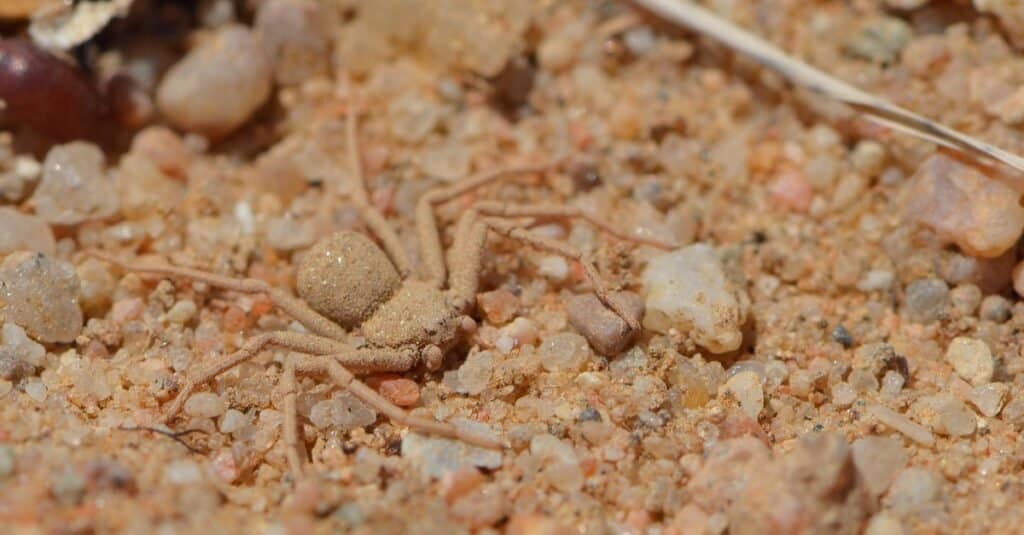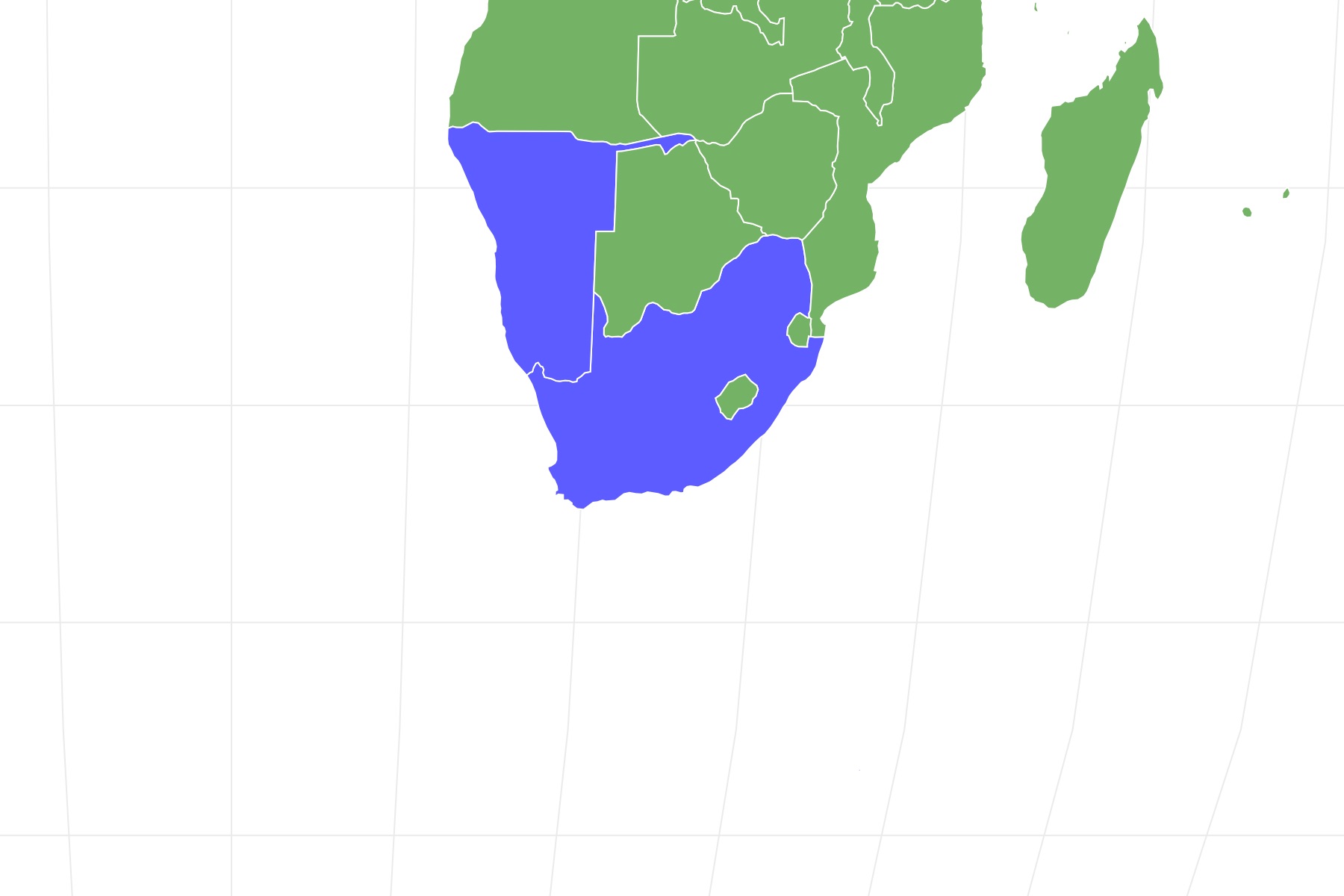Six-Eyed Sand Spiders
Sicarius Hahni
the six-eyed sand spider can survive without food for over a year!
Advertisement
Six-Eyed Sand Spiders Scientific Classification
- Kingdom
- Animalia
- Phylum
- Arthropoda
- Class
- Arachnida
- Order
- Araneae
- Family
- Sicariidae
- Genus
- Sicarius
- Scientific Name
- Sicarius Hahni
Read our Complete Guide to Classification of Animals.
Six-Eyed Sand Spiders Conservation Status
Six-Eyed Sand Spiders Facts
- Prey
- Insects, scorpians, small mammals
- Name Of Young
- spiderlings
- Group Behavior
- Solitary
- Fun Fact
- the six-eyed sand spider can survive without food for over a year!
- Estimated Population Size
- 200,000+
- Biggest Threat
- Lizards, snakes, birds
- Other Name(s)
- crab spider
- Litter Size
- 1000+
- Habitat
- Deserts
- Predators
- Birds, lizards
- Diet
- Carnivore
- Lifestyle
- Solitary
- Special Features
- Ability to camouflage in sand
- Slogan
- Camouflaged recluse with terrifying venom
View all of the Six-Eyed Sand Spiders images!
The Six-Eyed Sand Spider disguises itself on the desert floor by burying itself in the sand. They will surprise attack prey by leaping from the sand.
Six-Eyed Sand Spider Summary
The six-eyed sand spider is a species of arachnid living in deserts and hot, dry climates throughout Southern Africa. They get their name from the six eyes in three pairs on their head. These spiders are skilled hunters who ambush their prey and use their large, powerful fangs to inject their venom and subdue them. Finding this species would be incredibly difficult as they are masters of camouflage.
6 Incredible Six-Eyed Sand Spider Facts
1. It is a species of spider mainly living in deserts across Africa.
2. The six-eyed sand spider can survive up to 1 year without food or water.
3. It is one of the most venomous spiders in the world, and its bite can be fatal to humans.
4. They do not attack often, and there have only been 2 known cases where humans were bit by a six-eyed sand spider.
5. The spider buries itself in the sand and waits for prey to come within range before attacking.
6. It is also known as a crab spider due to its flattened stance.
Six-Eyed Sand Spider Scientific Name
Sicarius hahni
The scientific name for this spider is Sicarius hahni. The word “sicarius” means “murderer” or “assassin” in Latin. The spider has this name because of its aggressive nature when hunting prey.
Six-Eyed Sand Spider Appearance

Closeup picture of the six-eyed sand spider of the genus Hexophthalma photographed in the Namib desert near Swakopmund.
©Tobias Hauke/Shutterstock.com
The six-eyed sand spider has six eyes arranged on its head. These eyes give the spider excellent vision and help it to hunt prey effectively. Its body is medium-sized and broader than other similar spiders. It is brown, yellow, or reddish-brown in color and has short hairs all over. The spider has 8 legs that are long and thin. The ends of the legs have sharp claws for catching prey. The female of the species is about 2 inches across in diameter. Male six-eyed sand spiders are smaller than females, with slimmer bodies and shorter legs.
Six-Eyed Sand Spider Evolution
The six-eyed sand spider has undergone significant evolution to adapt to its environment. For example, its body has become more flattened and elongated, which helps it to move quickly through sand and dunes. Additionally, its legs have evolved to be very long and thin, which also aids in movement through the sand and allows the spider to cover itself with sand or flatten itself completely. This adaptation aids the spider in hiding from predators and camouflaging itself to sneak up on prey. This spider is an excellent example of how organisms can evolve to suit their environment better. Another desert adaptation is its ability to survive without food or water for up to 1 year. The six-eyed sand spider has undergone a great deal of evolution to survive and thrive in its habitat.
Six-Eyed Sand Spider Behavior
The six-eyed sand spiders are native to African deserts and are aggressive and venomous in nature. They are also swift and agile, making them difficult to catch. These spiders typically hunt quickly and aggressively, camouflaged and awaiting their prey while hidden in the sand or environment around them. When they sense their target, they quickly move toward it and attack. They are not aggressive towards humans and rarely bite. However, their venom is powerful enough to kill small mammals and even humans, so it is essential to be careful if you encounter one of these spiders in the wild.
Six-Eyed Sand Spider Habitat
The six-eyed sand spider is in hot, desert regions. Its habitat mainly consists of caves, crevices, and natural debris. They are most common in Southern Africa and live in remote, hot, and dry areas where humans seldom venture. The spider has long legs that move quickly over sand dunes. An abundance of these spiders are in fine sand patches. The spider does not live in a web or a den but instead buries itself in the sand.
Six-Eyed Sand Spider Diet
The six-eyed sand spider is a predatory species that feed on small insects and other arthropods. These spiders are known to be aggressive hunters and will even attack larger prey items if they can subdue them.
In terms of their specific prey, six-eyed sand spiders have been observed eating insects, scorpions, and other small animals. However, it is important to note that they are opportunistic hunters, so the diet of any given individual six-eyed sand spider can vary somewhat depending on the availability of prey items in its environment. For example, if there are few small insects around, a spider may be forced to eat larger prey, such as birds or even small rodents, to survive. Additionally, younger spiders tend to eat more frequently than adult spiders since they have yet to reach their full size.
What Eats the Six-Eyed Sand Spider?
It’s most significant predators are birds, reptiles, and amphibians.
What Does the Six-Eyed Sand Spider Eat?
They typically eats insects and scorpions. However, they can eat other spiders, small birds, or even small mammals.
Six-Eyed Sand Spider Predators and Threats
Considering that it can survive up to a year without food, the biggest threats to these spiders are predators such as birds, reptiles, and amphibians. These are all potential predators. However, with that said, it is reclusive in nature and camouflage make it a very difficult animal to hunt.
Six-Eyed Sand Spider Venom
It is believed to be one of the most venomous spiders in the world. Its venom is highly destructive and causes hemorrhaging, necrosis, blood vessel bursting, intense pain, swelling, and death. Only 2 people have ever been recorded to have been bit by one, so it is incredibly rare to be bit, and research on the venom is very limited.
Six-Eyed Sand Spider Reproduction
The females produce up to 1000 eggs which she then wraps in a web cocoon. Once the eggs hatch, the spiderlings will climb onto their mother’s back and stay there for several weeks until they are old enough to fend for themselves. The male spiders are much smaller than the females and do not live as long. Most spiders perform mating rituals for the male to get close enough to the female without triggering an aggressive response. If all goes correctly and mating is successful, the male must make a fast exit not to be eaten by the female spider. In many cases, the male is killed by the female after mating.
Six-Eyed Sand Spider Babies
While not much is known about six-eyed sand spiders as spiderlings, we know that they may climb onto their mother’s back after hatching until they are ready to be on their own. The father does not help with the young as he flees after mating or risks being devoured by the females.
Six-Eyed Sand Spider Lifespan
This spider is a fantastic creature with many exciting adaptations that help it survive in its environment. Female six-eyed sand spiders can live for up to 15 years, which is much longer than most other spiders. The lifespan of the males is not known but is predicted to be much shorter than females.
The six-eyed sand spider can go without food or water for an entire year. This is possible because the spider has adapted to store water in its body for longer, which helps it to survive during times when food and water are scarce. Some threats include, but are not limited to:
- Predators
- Disease
- Parasites
- Lack of food and water for over a year
Six-Eyed Sand Spider Population
The Sicarius hahni is a species in the more prominent family of spiders known as Sicariidae, which contains over 38,000 different species.
It is one of the most venomous spiders in the world, and its bites can be fatal to humans. There are 38,000+ identifiable species of sand spiders. However, because these spiders are excellent at hiding, it may be that there are over 200,000+ sand spider species in existence, in the wild South African desert.
Similar Animals
View all 292 animals that start with SSix-Eyed Sand Spiders FAQs (Frequently Asked Questions)
Are six-eyed sand spiders carnivores, herbivores, or omnivores?
The six-eyed sand spider is a carnivore as it primarily eats other animals.
Do six-eyed sand spiders mate for life?
The six-eyed sand spider does not mate for life. Instead, the female will typically devour the male spider after mating.
Which continents are six-eyed sand spiders found in?
The six-eyed sand spider is mainly found in the desert regions of Southern African countries such as Namibia and South Africa.
What is the average lifespan of a six-eyed sand spider?
The six-eyed sand spider is estimated to have a long lifespan, with some living up to 15 years.
Thank you for reading! Have some feedback for us? Contact the AZ Animals editorial team.















